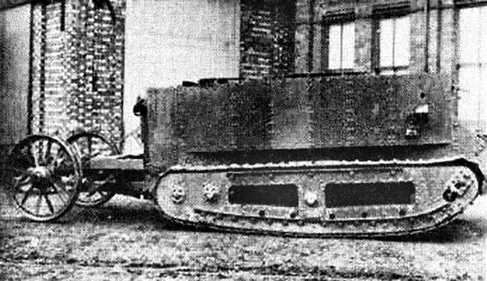The Number One Lincoln Machine, or “Little Willie”, is sometimes considered the world’s first tank. However, it only existed as a prototype, and was never engaged in battle.
Little Willie was sometimes known as the “Tritton Machine”, after one of its two designers: William Tritton, who was chief executive of William Foster and Co. Ltd. of Lincoln, England. Its other designer was Lt W.G. Wilson of the Royal Naval Air Service.
The design and construction of the first version of this 18 ton vehicle took place between August 2 and September 8, 1915.
The Number One Lincoln Machine had a rectangular hull. It was originally supposed to have a 2 pounder gun on a centrally mounted turret. However, a turret was never fitted. When Little Willie was first tested, a dummy turret was used.
Little Willie had a 6-cylinder, 105 horsepower, Daimler gasoline engine.

To improve steering and assist cross-country movement, wheels were added to the rear of the tank.
Little Willie had Bullock tracks that were imported from America.
The Number One Lincoln Machine moved very slowly. The first version could travel from 2 to 3 miles per hour (3.2-4.8kph). It could cross a trench that was no more than about 4 feet (1.2 meters) wide and climb a step that was no more than about 2 feet (0.61 meters) high.
Testing revealed that the tracks did not grip very hard and that they tended to fall off when the tank was crossing trenches.
The British War Office wanted a tank that could climb a 4 ½ foot (1.37 meter) step and cross a 5 foot (1.52 meter) trench, so Little Willie’s tracks had to be redesigned and rebuilt.
The redesigned tracks had cast steel plates that were riveted to links. These links had guides that interlocked with rails on the sides of the track frames. The frames themselves were longer than the track frames on the original version.
Until 1918, the tracks on all British tanks continued to be constructed this way.
As part of Little Willie’s redesign, the dummy turret was also removed.
The final version of Little Willie was finished in the beginning of December 1915.
Little Willie |
|
|---|---|
| Active: | 1915 (prototype) |
| Crew: | 4 to 6 |
| Weight: | 18 tons (18,290kg) |
| Length: | 18ft 2in (5.53m) |
| Height: | 10ft 2in (3.1m) |
| Width: | 9ft 4in (2.85m) |
| Weapons: | Main – 2 pounder 1.57 in (40mm) gun, Secondary – 1 x 0.303in (7.7m) Maxim machinegun, up to 3 x 0.303 in (7.7mm) Lewis machineguns |
| Armor | Maximum – 0.24 in (6mm) |
| Engine: | Daimler 6-cylinder gasoline, developing 105hp |
| Speed: | 2 mph (3.2kmh) |
| Range: | Unknown |